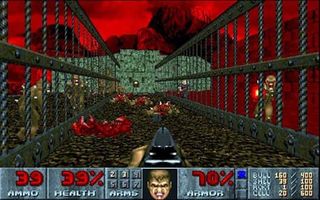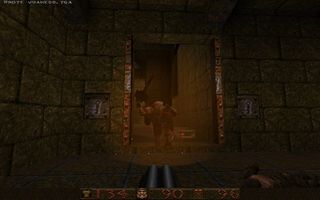While it may have built on the foundations of Wolfenstein 3D, Doom is id Software's most important title.
It pioneered key elements of the modern day FPS that are now taken for granted. Immersive, 'realistic' pseudo-3D graphics, the birth of the Deathmatch and co-op in networked multiplayer and customisable modding opportunities? You can direct your thanks towards Doom.
The fact that it is still a household name today and thoroughly played by a passionate and well established following only emphasises its significance.

With id's path clearly set thanks to the megaton impact of Doom, the sequel was little more than an evolution. There were no major steps forward in terms of technology or gameplay other than some minor structural changes to level design and the inclusion of new monsters and the double-barrelled Super Shotgun.
Don't you dare dismiss Doom II though. In 1994, more of the same was exactly what fans wanted and, with the sequel breaking away from id's usual shareware distribution routes and moving into shops, it was also a massive commercial success.

If you've ever found yourself at the mercy of a multiplayer FPS veteran, one grizzled gamer who seems able to hit a headshot from a hundred miles away, it's safe to say he cut his teeth on Quake.
Although Doom had its own multiplayer offering, it was in 1996 that the gamer's passion for twitch-based frag-fests online and all the kudos or ridicule that came with it really took off. The unique manoeuvrability in Quake contributed significantly, with techniques like bunny-hopping and strafe-jumping adding extra tactical dimensions.
Elsewhere, while Quake clearly borrowed a lot from Doom in terms of style, it made significant advances technologically. The transition to fully 3D graphics over 2.5D visuals was made, polygonal characters replaced the sprites of old and new lighting techniques made for an all round more impressive display.

Quake II, published by Activision, is the sequel to Quake in name only. The title was used by id Software after it had trouble acquiring the copyrights to use a different title.
In terms of single-player, Quake II departed from the original in style by bringing more narrative elements into play and story playing a more significant part more generally.
Mission-based objectives and basic cutscenes between levels contributed to the player's progression through a linear storyline while Quake was organised into four 'episodes' visiting different dimensions with around eight levels each.
While the technological advances between I and II were minor, the latter did feature some slight flourishes such as enemies sustaining visible wounds after being attacked. Oh, and players had the ability to crouch, if you can call that a technological advance.
